Purveyors of cryonic preservation have a problem: As long as customers are content with storing bodies at temperatures cold enough to liquify nitrogen (or colder), all is well. However, as soon as someone starts muttering about the end goal of waking frozen clients, the issue arises that nobody knows how to do that. In fact, freezing itself can damage human cells beyond repair. Humans being less robust than tardigrades, the humans have a deplorable tendency to remain quite dead despite the intense desires of the company that froze them. People are so inconsiderate.
However, even if cryonics were not just an expensive way of storing corpses, it still might be problematic for any number of reasons.
“Roger Dodsworth: The Reanimated Englishman” by Mary Shelley (1863)

Returning from Italy to England in 1654, Roger Dodsworth is buried by an avalanche. Rather than being pulverized, he falls into a state of preservation so perfect that reanimation is a simple matter of retrieving Roger from the snow and warming him up. Finding Roger was the difficult step—by the time he was found, the year was 1826.
What does Roger make of the new world in which he finds himself. Is the old Tory heartened to learn that Cromwell’s Commonwealth is no more, that monarchy once more rules England? Or is he distressed to discover the Stuart dynasty has been replaced by Hanoverian monarchs? Can a man of the past adapt to the futurist world of the 19th century? Or would Roger have been more fortunate to have perished in 1654?
Shelley was inspired by a famous newspaper hoax. The publication of this story was long delayed, by which time readers may well have forgotten the hoax. It is a shame cryopreservation isn’t a matter of well-timed avalanches. Imagine what we might learn from a reanimated Otzi.
“Time Heals” by Poul Anderson (1949)
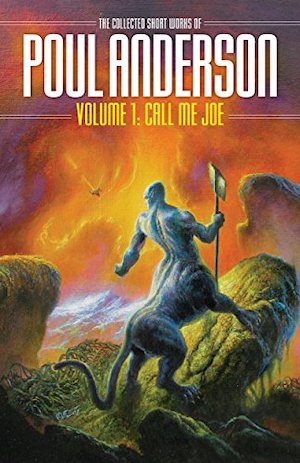
The Seaton effect avoids the issues of cryonics by stopping time itself. A terminally ill person like Hart may step into the field assured that they will be perfectly frozen in a moment of time—the only uncertainties are how long it will take for a cure for a terminal illness to be found, and into what sort of world Hart will emerge. Otherwise, the process is perfectly reliable and perfectly safe.
The good news is that a dystopia would not bother to wake or heal Hart. Hart’s hosts are in almost every respect superior to the people of Hart’s home time. Alas, the one comfort they cannot offer is a rewarding role for a barbarian like Hart to play in this new society. Nor, as it turns out, are they adept at addressing the psychiatric needs of a temporal castaway.
This does not go as well as it might have. Anderson is not the author to turn to for upbeat, happy resolutions. At least, Hart fares far better than the protagonist of another Anderson time castaway tale, “The Man Who Came Early”….
The Winds of Gath by E. C. Tubb (1967)
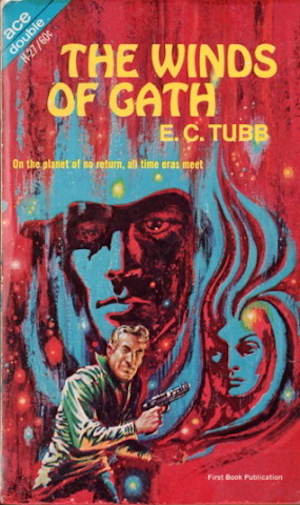
Determined to find his lost homeworld Earth, but financially strapped, interstellar traveller Dumarest has no choice but opt for Low Passage. Cold sleep is physically demanding, with a one in six chance of killing the sleeper. Low is also inexpensive, the only option Dumarest can afford.
Dumarest wakes to discover an unforeseen hazard of Low. He embarked intending to travel to thriving Broome. Dumarest wakes to discover the ship had been redirected to Gath, a backwater world offering few opportunities to earn passage off-world. Has Dumarest’s quest for Earth ended in this, the first of thirty-three novels?
It’s best not to do the math on “if Dumarest has a one in six chance of dying each time he travels in Low, what are the odds he survives thirty-three trips?” The venerable tabletop roleplaying game Traveller borrowed the concept of Low Passage, but players may be better at math than pulp heroes, as I rarely saw a player character actually risk it.1
The Tenth Planet by Edmund Cooper (1973)
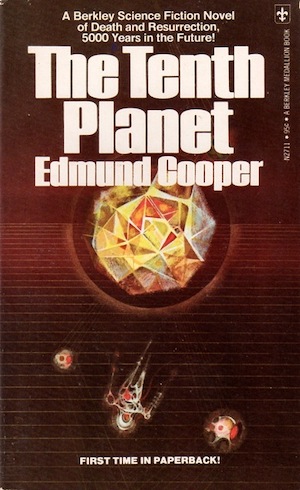
Industrial exuberance leads to ecological collapse. A small handful attempt to survive by fleeing to the Moon and Mars. Idris Hamilton’s command, the Dag Hammarskjold, is sabotaged by Terrestrial spoilsports who cannot bear to see others escape while they perish. Idris, his crew, and his passengers die immediately when the Dag Hammerskjold explodes.
Five thousand years later, Idris is restored to life on the icy world Minerva. Idris soon discovers there is no place for a relic like him on conservative, repressed Minerva, whose society is determined to avoid the self-inflicted suicides of Earth, the Moon, and Mars. Having repented of their decision to revive Idris, the Minervans seek an excuse to exile Idris to Minerva’s inhospitable surface. Idris is doomed, unless Earth is not quite as dead as feared, and if Idris can somehow reach it.
To be as charitable as possible, Idris is a nasty, abusive sexist and having him as the protagonist greatly undermines the thesis that it is the Minervans who are in the wrong. On the plus side, if I’m ever forced to assemble a list of protagonists who rated dead women by their bra size, Idris would be an obvious choice.
Cryoburn by Lois McMaster Bujold (2010)
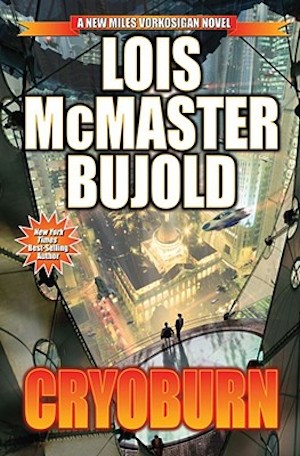
Dispatched to Kibou-Daini to assess the accuracy of Emperor Gregor’s suspicions concerning White Chrysanthemum Cryonics Corporation’s proposal to open a facility on Komarr, Miles Vorkosigan is no sooner offered a very promising bribe than he is targeted for kidnapping by local terrorist/freedom fighters New Hope Legacy Liberators. An atypical reaction to the kidnapper’s drugs sends a manic, delusional Miles scampering through an unfamiliar city. Rescue by a helpful local only brings further complications. As one should expect with Miles.
Surely Bujold’s characters should know by now that involving Miles in anything produces zany, unpredictable outcomes. But the New Hope Legacy Liberators do not seem overburdened with competence.
***
Suspended animation via whatever means is a story-rich premise, which is why the genre goes back centuries (hello, the Seven Sleepers!). Thus, there are many works I could have used, works that I passed by. Feel free to offer your own choices in comments below.
In the words of fanfiction author Musty181, four-time Hugo finalist, prolific book reviewer, and perennial Darwin Award nominee James Davis Nicoll “looks like a default mii with glasses.” His work has appeared in Interzone, Publishers Weekly and Romantic Times as well as on his own websites, James Nicoll Reviews (where he is assisted by editor Karen Lofstrom and web person Adrienne L. Travis) and the 2021, 2022, and 2023 Aurora Award finalist Young People Read Old SFF (where he is assisted by web person Adrienne L. Travis). His Patreon can be found here.
[1]The one exception during Traveller gameplay being the crew of a ship that ended up in deep space without sufficient fuel to Jump. No alternative but the slow route, with the crew frozen in Low. Interesting trivia: prior to the calamity, everyone who used this ship’s Low berths died during revival.










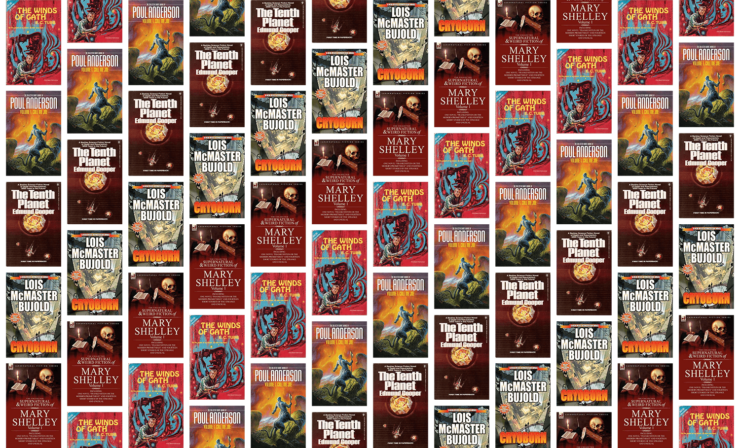
In the Roger Zelazny novel Doorways in the Sand, Fred Cassidy’s Uncle Al had himself frozen. Why? We don’t know. The company was called “Bide-a-Wee” indicating that some people just need to skip a few years. Of course, the clients didn’t know that Bide-a-Wee was only profitable by selling off the parts of most of their clients in the black market organ- and bodypart-trade. Uncle All was one of the lucky ones, kept around as a display model in case someone wanted to visit a relative or friend (because one frosted frozen body looks much like another).
Anne McCaffrey’s Death of Sleep has the heroine avoiding disaster via cryosleep a couple of times. It’s better than dying but seems like it’d get exhausting after awhile.
I simply cannot fathom why writers and referees allow low berths to be lethal. (I blame the sociopathy of all grognards.) At any table of mine, the Medic roll only determines how many hours (or, if it fails, days) the erstwhile corpsicle has freezer lag for.
(RAW at least in Mongoose, most ships only have fuel bunkerage for one jump and two weeks of operation, so those aboard a ship that misjumps into an empty hex can only choose what temperature they will die at. (Not to mention they adopted T5’s well-meaning but canon violating ‘maneuver drives work for crap away from gravity wells’, so misjumped ships aren’t limping to safety anyway.) The writers of GURPS know how much energy fusion provides, so apart from jump GURPS Traveller ships never need to take on fuel.)
Classic Traveller’s low berth is potentially lethal because it is a homage to the Dumarest stories. In fact, there are drugs that will give much the same effect in CT but for some reason people don’t use them.
@@.-@: They see use, if not for that – when my character got downed in combat a few sessions ago, our medic immediately shot him up with fast drug to stabilize him until she got him back to the ship, then used slow drug so he recovered in hours rather than days. Per the literature, high passengers often use fast drug to stave off ennui and/or space madness.
(Our current situation requires us to do lots of consecutive jumps (our ship has jump-1 but lots of bunkerage). I wish our referee was using the space madness rules – it would be fun to see how us players try to keep morale up in the deep dark.)
Still a top-shelf read, Philip K. Dick’s novel Ubik sets suspended animation as the linchpin for a story that certainly delves further into reality than awakening to a new world! Way before the blue pill, there was Ubik.
Every time cryonics comes up I mention “Legacy of Heorot” where cold sleep has some unfortunate side-effects. The last good Niven/Pournelle collaboration, possibly only good because Barnes was there too. The sequels aren’t good. Which is unfortunate, since they have some good ideas.
If you like dark comedy vibes in your sci-fo, you should check the Red Valley podcast as well :-)
One of my first encounters with cryogenics and suspended animation was a YA SF novel that I read when I was 12, set in a dystopian future community where dissenting members are frozen in lieu of execution; the main character is a young woman who begins to question her “perfect” society.
Unfortunately, I do not recall either the author or the title, only the general plot, the cover, and the fact that one of my classmates made fun of me for reading a book with a “girl” on the cover (which, in retrospect, may have been par for the course for 12-year-old boys in the early ‘80s).
Transmitting the just-discovered formula for cold sleep to the resistance (so they can GTFO of a tyrannical Earth) makes up much of the action of the first half of Andre Norton’s The Stars Are Ours!. (Much of the rest of the section is involved with dodging not just the authorities but also peasants with torches ordinary people who have been taught that science is taboo.)
In The Door Into Summer, cold sleep is so routine that the narrator does it twice (having time-traveled back to his starting point), and his RAH-fetish has left instructions to be awakened only when he shows up.
Pohl’s “The Fiend” is not the earliest brain-running-a-spaceship story (ISFDB places it 3 years after the original “The Ship Who Sang”), but it’s a cautionary about picking who stays awake to monitor the cold-sleep machinery. Other stories similarly think people will be woken in rotation, as if cold sleep is so reliable that it can be done repeatedly and so simple that going into it can be managed entirely by machines; ISTR van Vogt using this decades before it’s shown in Alien, and not in the story the movie was drawn from, but I’m blanking on the title. (ISTR it’s not the only story in which a cold-sleep ship reaches its destination only to find that somebody has discovered FTL drive in the interim.)
Glen Cook’s The Dragon Never Sleeps has large chunks of the Guardships’ crews in cold sleep, to be thawed out when their services are needed. (The Guardships’ creators understood that social changes meant that organizations decayed, so they chose to freeze and clone the founding generation so there wouldn’t be a decay… of course, society still went ahead and evolved over time, which led to friction between the Guardships and the society they protected.)
Greg Bear’s novella Heads involves a research project with a bunch of the title body parts: it turns out that although there’s no chance of reviving any frozen people, you might be able to read some of their memories. Things get dangerous when a powerful religious/political group finds out their founder’s head might be in the pile, since not only might there be something controversial in his memories, but just the idea that he had had himself frozen would imply he was a mortal man who feared death.
I have to add Love Minus Eighty by Will McIntosh, which answers the question “What if we tried to combine dating and cryo?” and takes it in a pretty dark direction. Great novel.
The Godwhale by T.J. Bass provides another excellent example of the problem with safe, reliable coldsleep that has no defrost-by date. Larry Dever suffers a terrible disabling accident. Unwilling to live with the mobility aids available at the time, he decides to go into coldsleep until a solution can be found. He is awakened and informed that a solution has been found: they cloned him, and now that the clone is old enough they are going to use him as a tissue bank for Larry, because future medical ethicists are OK with that. Horrified, Larry demands to go back into coldsleep instead. But the second time he is defrosted, he is literally dumped. He was an interesting example of ancient humanity the first time, but now he is just excess inventory. Post-human consciousness has arrived, and it is just as dreary as dispassionate, all-knowing post-human consciousness is bound to be. He has to survive in a world that has no place for him whatsoever. Luckily for him, he is not the only discard eking out a life in the interstices of the mighty, perfect-because-they-say-so planned society of the future.
Fred Pohl’s The Age of Pussyfoot is about a contemporary man who fails to read the information provided to him when he’s thawed out. This leads to a number of erroneous conclusions and serious mistakes.
Larry Niven’s “A Gift From Earth” has the colonists on the ship taking them to their new home frozen for decades, whilst the crew remain awake, to keep things running. Unfortunately, upon finally reaching their destination, the crew seize control of the new world, and the colonists, setting themselves up as rulers, with the suspended animation facilities on the starship being turned into organ banks, storing organs from involuntary colonist donors.
Of course, a resistance movement arises.
@10, are you thinking of “Far Centaurus”?
If the trials are all independent then of course it’s much less than 1%… but (not having read any of the novels) I doubt that Tubb gave enough information to determine if they are independent. Maybe one’s physiology determines the probability of surviving Low Passage and Dumarest happens to have a very high probability.
Niven’s “Rammer” and World Out of Time use this trope but of course they were mentioned just recently. Niven used it in other stories as well.
In Zelazny’s “The Keys to December” cold-sleep is used to allow time to terraform a planet so the sleepers can survive on it.
The protagonist of Steve Savitzky’s song “Stuck Here” is an uploaded personality captaining a slowboat full of corpsicles, but they don’t really enter into it.
Earl Dumarest canonically has a quite high Endurance stat (his UPP is BFCA98), but in the 1981 rules that doesn’t confer a DM on the survival throw. (A low END gives a negative DM.)
Martin Silenus, the Poet in Dan Simmons’ Hyperion, travels via cold sleep and emerges one of the lucky five out of six who survive (possibly another Dumarest reference) but with significant brain damage. His vocabulary, listed but mercifully only portrayed once as an example, consists of nine words the mildest of which are ‘poopoo’ and ‘peepee.’ He gets better. At least in terms of vocabulary.
Earl Dumarest isn’t constrained by the game mechanics of Traveller, so he can improve his own odds by keeping himself physically fit, and by choosing ships which have decent equipment and a reasonably skilled “handler” for the Low passengers. Even without the plot armour conferred by his status as protagonist, his odds of survival are still way better than most people’s.
The situation – a viewpoint character essentially adrift in an unfamiliar world – has a certain amount of comedy potential, as demonstrated in things like Futurama and Red Dwarf.
I’m inclined to mention Bruce Sterling’s Schismatrix, in which some groups deal with prominent politicians whose views they dislike by “ice assassination” – kidnapping the politicians in question and keeping them in cryonic stasis until they’re no longer relevant. (Seems to me that it’s something that could backfire, badly. Suppose someone did it to, well, a certain political figure today, only to have him come back in about 2050 to say “My faithful! I have returned! Now I will lead you, and together we will make America great again!” Doesn’t bear thinking of.)
The Centurion’s Empire, by Sean McMullen, is about a Roman centurion, using cold sleep to time travel into the future, on the run from adversaries who have also discovered the secret. It is quite a thriller.
@23: Just the one I was going to mention.
Pohl and Sheffield each have a story about cold sleep for religious reasons (“Redemption in the Quantum Realm” (if I remember the plot correctly) and “Nightmares of the Classical Mind”)
Assuming independent trials, I put Dumarest’s chances at one in 410. More likely, genuine Earth people and protagonists get better odds.
Always ready with the obvious, I mention 2001: A Space Odyssey and Star Trek’s classic episode, ‘Space Seed’, both of which assume we’ll have suspended animation figured out long before now.
I suppose as long as I’m at it, I’ll include Roddenberry’s failed pilots, Genesis II and Planet Earth, the latter being a somewhat retooled sequel to the first, with the inimitable John Saxon replacing Alex Cord as Dylan Hunt (a far cooler name than the Mission: Impossible film franchise’s Ethan Hunt) the 20th century scientist accidentally entombed by an earthquake in a cryogenic storage facility for 200 years. I really only remember bits of these two, and bend much more favourably toward the first, which also featured Star Trek alumnae Mariette Hartley, Ted Cassidy, and Majel Barrett. The second version involved Saxon being held captive in a post-apocalyptic matriarchal society, and one can easily imagine how that plotline went.
Speaking of names, I also loved the name of another of the Genesis II characters, Harper-Smythe, as well as the organisation dedicated to rebuilding civilisation, PAX. It’s a shame the show didn’t succeed.
Anne Leckie’s Ancillary Justice includes lots of frozen bodies. Most are the reserves of prisoners of war, frozen and stored aboard artificially intelligent starships for the day they will need to be thawed and implanted with the hardware that will that assimilate them as ancillary crew or soldiers in other star systems and other centuries. (The main character, Breq, is the last surviving ancillary of Justice of Toren.) Jumping into an escape pod and being frozen for centuries brought former Justice of Toren officer Seivarden into a radically changed empire where they were no longer among the social elite.
There’s also “Transmetropolitan,” the comic book series by Warren Ellis and Darick Robertson. One of the side characters is Mary, a woman who’s been in cryogenic stasis for a long, long time. When she’s revived, she’s desperately not ready for the horrors of the future — just like all the other Revivals, who generally end up homeless or catatonic. Mary is one of the few who eventually makes her way back toward a semi-normal life…
In MTU (my traveller universe) Low was only dangerous if maintenance hadn’t been done, if you didn’t have anyone with any medical skill or you were at the first TL it was available at. Otherwise it was as safe as anything in life is.
Same as “dying in character generation”. Nope. Serious injury, career over, subtract one from one stat & start play at that point.
We won’t mention computers or pirates ;)
Traveller is still a great TTRPG but there are places were it’s 1977 roots show through way too clearly. Thank the stars for house rules! I played it for years before I ever heard of this D&D thing LOL!
You left out James White’s SECOND ENDING. One of the great ones, imho. First serialized in Cele Goldsmith’s Fantastic in 1971, eventually winding up as the B-Side of an Ace Double with Samuel Delany’s JEWELS OF APTOR
https://www.goodreads.com/en/book/show/18493395
@17: “Far Centaurus” it is — the plot summary in Wikipedia matches everything I remembered. (Although I see that technically it’s not cold sleep, just a miracle drug.) Thanks!
Stanley Schmidt specifically warned potential submitters to Analog against cryonics stories. It wasn’t the technology itself that was the problem, but the specific plot where a present-day person is unfrozen in the future and is a convenient relatable viewpoint character for the setting. Schmidt said he’d read so many waking-up-in-the-future scenes he thought they were generated with a keyboard macro.
Lockstep by Karl Schroeder features an entire interstellar civilization based on cold sleep cycles to negate the delays of long space voyages and to mitigate the effects of industry on ecologies.
The earliest story I can recall in which cold sleep is Russian roulette is Heinlein’s The Rolling Stones (1952). It’s the reason Papa Stone won’t go along with the twins’ plan to haul hibernating prospectors to Mars.
@18,25 Good to see I’m not the only one whose reaction to “Don’t do the math” is to do the math : ). Even assuming independent trials, Dumarest’s survival could be accounted for by selection bias, if we additionally assume that the (in world) narrator decided to write about him only AFTER he survived 33 Low Passages. After all, it’s much more interesting to write about the one fool who survived than the 409 who didn’t!
Clifford Simak wrote a whole novel about a society molded by widespread adoption of cryogenics, Why Call Them Back from Heaven?. To my mind it was more or less ruined by the utter implausibility of the premise.
Anybody feel like mentioning Anthony Rogers, who was trapped in a mine cave-in and held in suspended animation for 500 years? He finally came out of it to find that Yellow Peril Asians had conquered the US.
And then there’s Steve Rogers (probably no relation) who was frozen in an ice floe for a variable amount of time ranging from 18 years to, currently I think about 65.
@34: a lesser known series featuring Dum of Terra came to an abrupt end when the main character failed to survive his first trip.
@33 Heinlein also mentioned “cold sleep” in “Methuselah’s Children (1941), as a choice for the passengers aboard the hijacked colony ship; but since the Howard Families’ members had such extended lifespans, it was more a matter of preference of not enduring the long, boring voyage at near-light speed to the nearest inhabitable extrasolar planet.
@36: “Dum of Terra” being short for “DumaRest-in-Peace of Terra”
Does “The Sliced-Crosswise Only-On-Tuesday World” by Philip Jose Farmer count?
Then-Lieutenant Vorkosigan had an even closer encounter with cryonics back in Mirror Dance, when it was applied as an emergency medical procedure after the unfortunate business with the needle grenade.
I think Saturn’s Children had our robot protagonist doing some sort of cold sleep, although it may have been just switching off.
Stanislaw Lem’s Fiasco features a viewpoint character (in the main part of the story) who is a reconstituted composite of two people cryofrozen on Titan centuries before in the first chapter. They had both gotten themselves into trouble while manning giant mechas on Titan’s frozen surface–the second person having heroically but foolhardily gone out in search of the first after the latter’s disappearance. The freezing process is brutal: the person’s brain has to be flash-frozen with good deal of violence done to the rest of the person’s body.
As I think I’ve mentioned in response to one of James’s other essays, there’s a problem with long-term “storage” if it stops biological activity but not radioactivity — e.g. frozen but not time-stopped. Our bodies contain small amounts of naturally-radioactive isotopes including carbon 14, and that includes the DNA. Occasionally, a DNA strand goes spung. If the cell is up and running, its mechanisms will either repair the DNA or kill the cell… usually. The failures can lead to things like cancers. If cells die, there are mechanisms to replace them. But if all of the body’s maintenance stuff is put on hold while the damage accumulates, there are likely to be serious health problems when the patient / subject is brought round. “Hibernation” as in 2001 could avoid this, and it’s probably not going to be an issue for completely time-stopped stasis field thingies.
Jack Campbell’s “The Lost Fleet” setting, which of course has principal character John Geary frozen in a space lifepod for about a century, has in the latest instalment, “Implacable”, people making excess distance interstellar jumps, believing that their innate superiority to ordinary people will prove they are immune to Severe Jump Space Syndrome which basically turns you insane for up to a year, and finding out that they aren’t. Besting a cryonic casualty rate by personal greatness is equally unlikely. I wonder if Earl Dumarest was meant by the author to find Earth sooner, or at all.
Another Lost Fleet universe character, Roh Morgan (from a world with many Camelot characters, clearly she’s their Morgan le Fay) was sent to explore alien space the slow way, frozen. And apparently was found by the aliens and sent back without doing any exploring. And she’s pretty crazy, but apparently she was crazy before that. I think that out of story, she was frozen just to make her older than she appears, too.
Mentioned in Douglas Adams’s “Life, the Universe, and Everything” is a xenophobic planet that wants to destroy all life in the universe that isn’t them. The planet is placed in time stasis until the heat death of the rest of the universe, so they can come out then and have it to themselve. This is not their story, except when it is.
Three Heinlein novels have already been mentioned. I’ll add a fourth: Podkayne of Mars. Heinlein has commercial newborn baby freezing as “It reconciles that discrepancy, so increasingly and glaringly evident ever since the Terran Industrial Revolution, between the best biological age for having children and the best social age for supporting and rearing them”.
Slightly off the point, but a plot detail of Phil and Kaja Foglio’s “Girl Genius” webcomic and novels is that the aristocracy of outright mad scientists who made the world what it is, a war-torn wasteland, mostly respect a rule that when you are medically dead, your heirs inherit your stuff, your spouse can legally remarry, and if you come back, alive or technically still dead, you can’t claim back any of that. Scientific resurrection is different from being kept frozen, but on the other hand, there are Frankenstein-type rebuilt “construct” people around in this setting. One of the notorious Heterodyne family has been buried many, many times, but it’s implied that he is a vampire. But it’s supposed to be science fiction, so that probably isn’t exactly true.
I think Star Trek episode “The Neutral Zone” also had some characters taking a line that once you’re frozen dead, your personhood is suspended. That is the one with the annoying twentieth century characters who aren’t evil supermen, but, of course, they were unfrozen. And were treated kindly, but the unfreezing wasn’t treated as something owed to them. Possibly Starfleet has an actual policy against raising the apparently dead, it’s caused trouble so many times.